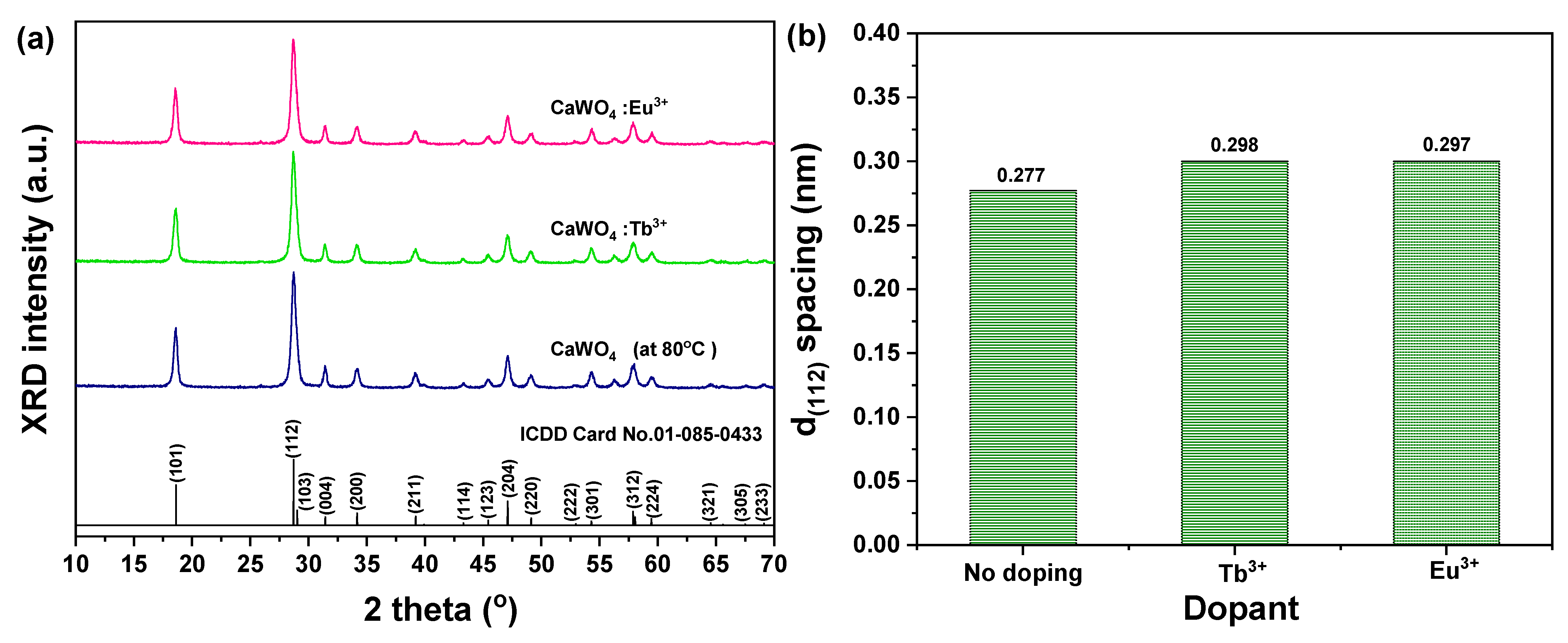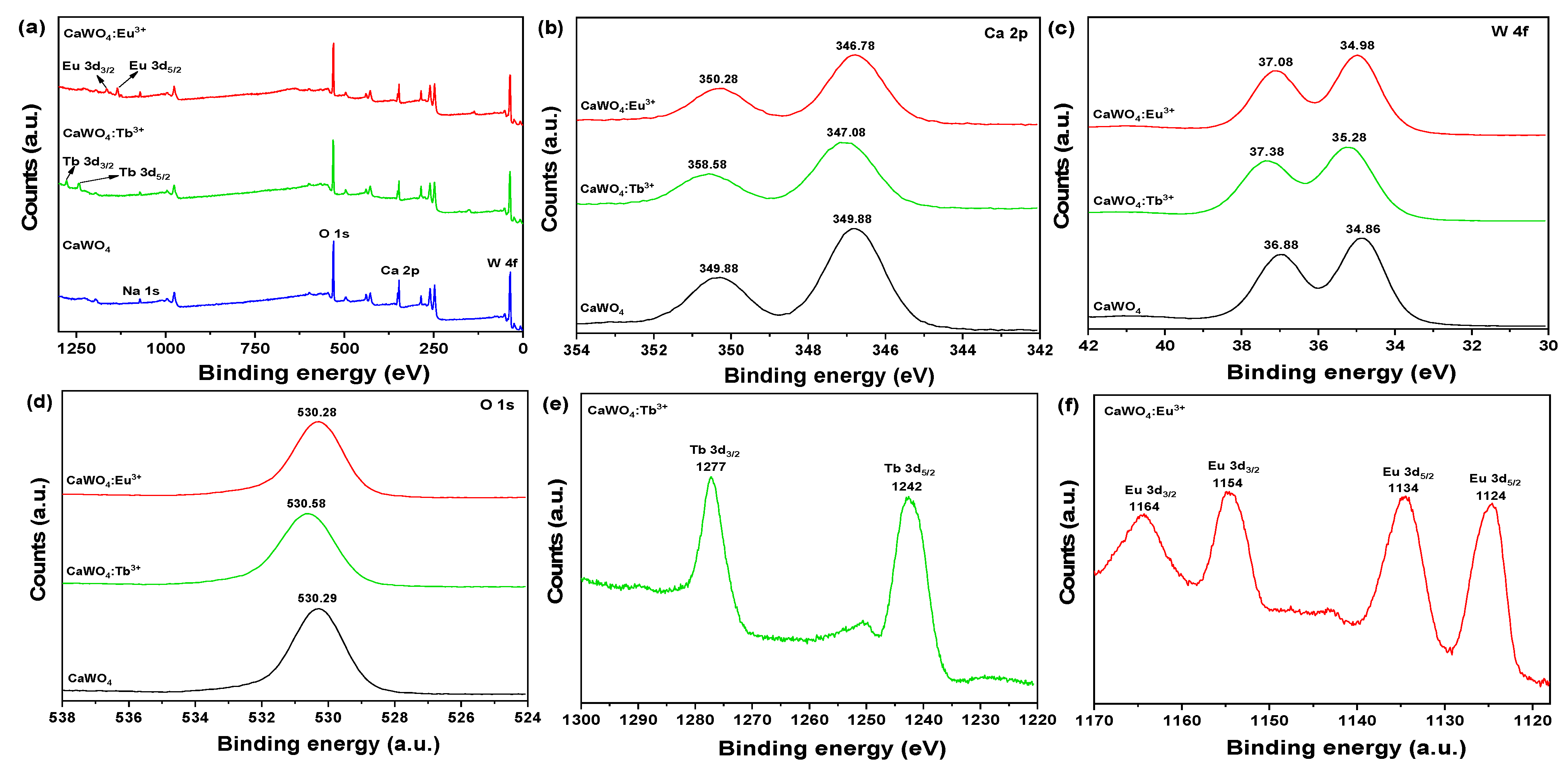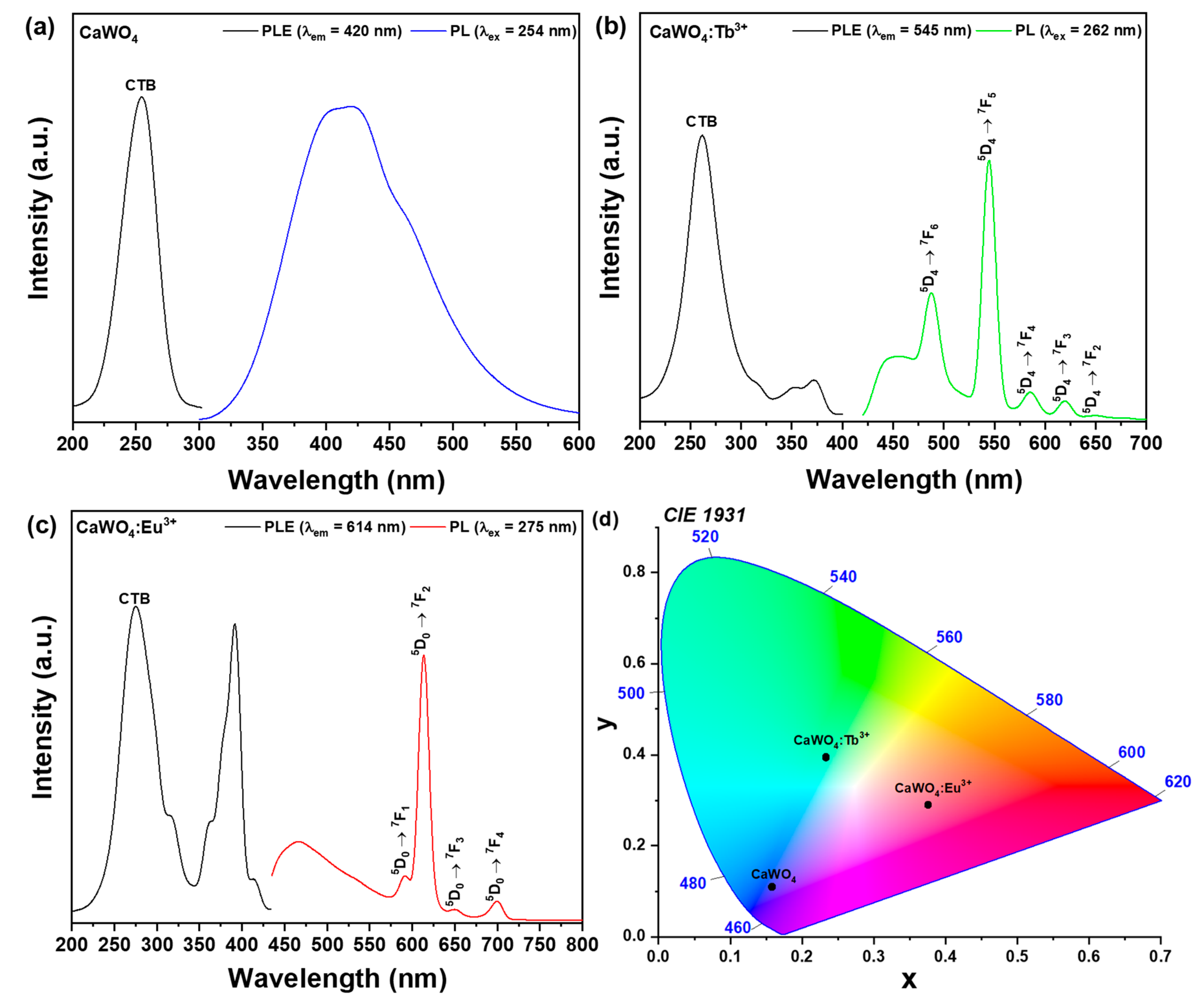Calcium Tungstate Doped with Rare Earth Ions Synthesized at Low Temperatures for Photoactive Composite and Anti-Counterfeiting Applications
Abstract
:1. Introduction
2. Materials and Methods
2.1. Crystalline CaWO4 Synthesized at Low Temperature
2.2. Characterization
2.3. Fabrication of Photoactive Composite and Anti-Counterfeiting Application
3. Results and Discussion
3.1. Structural and Morphology
3.2. Chemical States and Phtoluminescence Proeprties
3.3. Photoactive Composite and Anti-Counterfeiting Application
4. Conclusions
Author Contributions
Funding
Institutional Review Board Statement
Data Availability Statement
Acknowledgments
Conflicts of Interest
References
- Liu, C.; Pokhrel, S.; Tessarek, C.; Li, H.; Schowalter, M.; Rosenauer, A.; Eickhoff, M.; Li, S.; Mädler, L. Rare-Earth-Doped Y4Al2O9 Nanoparticles for Stable Light-Converting Phosphors. ACS Appl. Nano Mater. 2019, 3, 699. [Google Scholar] [CrossRef] [Green Version]
- Withnall, R.; Silver, J. Physics of Light Emission from Rare Earth-Doped Phosphors. Handb. Vis. Disp. Technol. 2015, 1, 1019–1028. [Google Scholar] [CrossRef]
- Kim, D. Recent Developments in Lanthanide-Doped Alkaline Earth Aluminate Phosphors with Enhanced and Long-Persistent Luminescence. Nanomaterials 2021, 11, 723. [Google Scholar] [CrossRef] [PubMed]
- Parhi, P.; Karthik, T.N.; Manivannan, V. Synthesis and characterization of metal tungstates by novel solid-state metathetic approach. J. Alloy Compd. 2008, 465, 380–386. [Google Scholar] [CrossRef]
- Zhang, J.; Zhu, X.; Huang, H.; Zhang, Y. Synthesis of Crystallized BaWO4 Nanorods in a Microemulsion System. Adv. Chem. Eng. Sci. 2017, 7, 228–234. [Google Scholar] [CrossRef] [Green Version]
- Kuzmin, A.; Purans, J. Local atomic and electronic structure of tungsten ions in AWO4 crystals of scheelite and wolframite types. Radiat. Meas. 2001, 33, 583–586. [Google Scholar] [CrossRef]
- Smith, J.; Desgreniers, S.; Tse, J.; Klug, D. High-pressure phase transition observed in barium hydride. J. Appl. Phys. 2007, 102, 043520. [Google Scholar] [CrossRef]
- Liao, J.; Qiu, B.; Wen, H.; Chen, J.; You, W.; Liu, L. Synthesis process and luminescence properties of Tm3+ in AWO4 (A = Ca, Sr, Ba) blue phosphors. J. Alloy. Compd. 2009, 487, 758–762. [Google Scholar] [CrossRef]
- Sota, E.N.; Che Ros, F.; Hassan, J. Synthesis and Characterisation of AWO4 (A=Mg, Zn) Tungstate Ceramics. J. Phys. Conf. Ser. 2018, 1083, 12002. [Google Scholar] [CrossRef] [Green Version]
- Cooper, T.; De Leeuw, N. A combined ab initio and atomistic simulation study of the surface and interfacial structures and energies of hydrated scheelite: Introducing a CaWO4 potential model. Surf. Sci. 2003, 531, 159–176. [Google Scholar] [CrossRef]
- Oliveira, M.C.; Gracia, L.; Nogueira, I.C.; do Carmo Gurgel, M.F.; Mercury, J.M.R.; Longo, E.; Andrés, J. Synthesis and morphological transformation of BaWO4 crystals: Experimental and theoretical insights. Ceram. Int. 2016, 42, 10913–10921. [Google Scholar] [CrossRef] [Green Version]
- Zhang, H.; Liu, T.; Zhang, Q.; Wang, X.; Yin, J.; Song, M.; Guo, X. First-principles study on electronic structures of BaWO4 crystals containing F-type color centers. J. Phys. Chem. Solids 2008, 69, 1815–1819. [Google Scholar] [CrossRef]
- Yekta, S.; Sadeghi, M.; Babanezhad, E. Synthesis of CaWO4 nanoparticles and its application for the adsorption-degradation of organophosphorus cyanophos. J. Water Process. Eng. 2016, 14, 19–27. [Google Scholar] [CrossRef]
- Balestrieri, M.; Colis, S.; Gallart, M.; Schmerber, G.; Ziegler, M.; Gilliot, P.; Dinia, A. Photoluminescence properties of rare earth (Nd, Yb, Sm, Pr)-doped CeO2 pellets prepared by solid-state reaction. J. Mater. Chem. C Mater. Opt. Electron. Devices 2015, 3, 7014–7021. [Google Scholar] [CrossRef] [Green Version]
- Oh, W.; Chong, Y.; Park, C.S. Lim Solid-State Metathetic Synthesis and Photoluminescence of Calcium Tungstate Particles Assisted by Cyclic Microwave Irradiation. Asian J. Chem. 2012, 24, 3319. [Google Scholar]
- Phuruangrat, A.; Thongtem, T.; Thongtem, S. Synthesis, characterisation and photoluminescence of nanocrystalline calcium tungstate. J. Exp. Nanosci. 2010, 5, 263–270. [Google Scholar] [CrossRef]
- Li, J.; Zhang, J.; Hao, Z.; Zhang, X.; Zhao, J.; Luo, Y. Upconversion properties and dynamics study in Tm3+ and Yb3+ codoped CaSc2O4 oxide material. J. Appl. Phys. 2013, 113, 223507. [Google Scholar] [CrossRef]
- Jung, J.; Kim, J.; Shim, Y.; Hwang, D.; Son, C.S. Structure and Photoluminescence Properties of Rare-Earth (Dy3+, Tb3+, Sm3+)-Doped BaWO4 Phosphors Synthesized via Co-Precipitation for Anti-Counterfeiting. Materials 2020, 13, 4165. [Google Scholar] [CrossRef]
- Jung, J.; Yi, S.; Hwang, D.; Son, C. Structure, Luminescence, and Magnetic Properties of Crystalline Manganese Tungstate Doped with Rare Earth Ion. Materials 2021, 14, 3717. [Google Scholar] [CrossRef]
- Wang, S.; Gao, H.; Sun, G.; Li, Y.; Wang, Y.; Liu, H.; Chen, C.; Yang, L. Structure characterization, optical and photoluminescence properties of scheelite-type CaWO4 nanophosphors: Effects of calcination temperature and carbon skeleton. Opt. Mater. 2020, 99, 109562. [Google Scholar] [CrossRef]
- Jia, Y.Q. Crystal radii and effective ionic radii of the rare earth ions. J. Solid State Chem. 1991, 95, 184–187. [Google Scholar] [CrossRef]
- Bokuniaeva, A.O.; Vorokh, A.S. Estimation of particle size using the Debye equation and the Scherrer formula for polyphasic TiO2 powder. J. Phys. Conf. Ser. 2019, 1410, 012057. [Google Scholar] [CrossRef]
- Thongtem, T.; Kungwankunakorn, S.; Kuntalue, B.; Phuruangrat, A.; Thongtem, S. Luminescence and absorbance of highly crystalline CaMoO4, SrMoO4, CaWO4 and SrWO4 nanoparticles synthesized by co-precipitation method at room temperature. J. Alloy Compd. 2010, 506, 475–481. [Google Scholar] [CrossRef]
- Kaur, P.; Khanna, A.; Singh, M.N.; Sinha, A.K. Structural and optical characterization of Eu and Dy doped CaWO4 nanoparticles for white light emission. J. Alloy Compd. 2020, 834, 154804. [Google Scholar] [CrossRef]
- Maheshwary, M.; Singh, B.P.; Singh, R.A. Color tuning in thermally stable Sm3+-activated CaWO4 nanophosphors. New J. Chem. 2015, 39, 4494–4507. [Google Scholar] [CrossRef]
- Terohid, S.; Heidari, S.; Jafari, A.; Asgary, S. Effect of growth time on structural, morphological and electrical properties of tungsten oxide nanowire. Appl. Phys. A 2018, 124, 1–9. [Google Scholar] [CrossRef] [Green Version]
- Pawlak, D.A.; Ito, M.; Oku, M.; Shimamura, K.; Fukuda, T. Interpretation of XPS O (1s) in Mixed Oxides Proved on Mixed Perovskite Crystals. J. Phys. Chem. B 2002, 106, 504–507. [Google Scholar] [CrossRef]
- Fang, Z.B.; Wang, J.J.; Yang, X.F.; Chen, T.H.; Ni, H.N.; Li, Z.B.; Tan, Y.S. Reliability Study of the Band Gap of Rare Earth Oxides Measured by XPS Spectra. Key Eng. Mater. 2013, 562–565, 891–895. [Google Scholar]
- Park, K.; Ahn, H.; Nguyen, H.; Jang, H.; Mho, S. Optical Properties of Eu2(WO4)3 and Tb2(WO4)3 and of CaWO4 Doped with Eu3+ or Tb3+—Revisited. J. Korean Phys. Soc. 2008, 53, 2220–2223. [Google Scholar] [CrossRef]
- Wang, W.; Yang, P.; Gai, S.; Niu, N.; He, F.; Lin, J. Fabrication and luminescent properties of CaWO4: Ln3+ nanocrystals. J. Nanoparticle Res. 2010, 12, 2295. [Google Scholar] [CrossRef]
- Cavalli, E.; Boutinaud, P.; Mahiou, R.; Bettinelli, M.; Dorenbos, P. Luminescence Dynamics in Tb3+-Doped CaWO4 and CaMoO4 Crystals. Inorg. Chem. 2010, 49, 4916–4921. [Google Scholar] [CrossRef]
- Sun, S.; Wu, L.; Yi, H.; Wu, L.; Ji, J.; Zhang, C.; Zhang, Y.; Kong, Y.; Xu, J. Energy transfer between Ce3+ and Tb3+ and the enhanced luminescence of a green phosphor SrB2O4:Ce3+, Tb3+, Na. Opt. Mater. Express 2016, 6, 1172. [Google Scholar] [CrossRef]
- Alaria, J.; Borisov, P.; Dyer, M.S.; Manning, T.D.; Lepadatu, S.; Cain, M.G.; Mishina, E.D.; Sherstyuk, N.E.; Ilyin, N.A.; Hadermann, J.; et al. Engineered spatial inversion symmetry breaking in an oxide heterostructure built from isosymmetric room-temperature magnetically ordered components. Chem. Sci. 2014, 5, 1599–1610. [Google Scholar] [CrossRef] [Green Version]
- Nayak, P.; Nanda, S.S.; Sharma, R.K.; Dash, S. Tunable luminescence of Eu3+-activated CaWO4 nanophosphors via Bi3+ incorporation. Luminescence 2020, 35, 1068–1076. [Google Scholar] [CrossRef]
- Malta, O.L.; Ribeiro, S.J.L.; Faucher, M.; Porcher, P. Theoretical intensities of 4f-4f transitions between Stark levels of the Eu3+ ion in crystals. J. Phys. Chem. Solids 1991, 52, 587–593. [Google Scholar] [CrossRef]
- Savinov, M.; Nuzhnyy, D.; Ležaić, M.; Eckel, S.; Kamba, S.; Laufek, F.; Spaldin, N.A.; Knížek, K.; Vaněk, P.; Lamoreaux, S.K.; et al. A multiferroic material to search for the permanent electric dipole moment of the electron. Nat. Mater. 2010, 9, 649–654. [Google Scholar] [CrossRef]
- Kolesnikov, I.E.; Povolotskiy, A.V.; Mamonova, D.V.; Kolesnikov, E.Y.; Kurochkin, A.V.; Lähderanta, E.; Mikhailov, M.D. Asymmetry ratio as a parameter of Eu3+ local environment in phosphors. J. Rare Earths 2018, 36, 474–481. [Google Scholar] [CrossRef]
- Jung, J.Y.; Shim, Y.; Son, C.S.; Kim, Y.; Hwang, D. Boron Nitride Nanoparticle Phosphors for Use in Transparent Films for Deep-UV Detection and White Light-Emitting Diodes. ACS Appl. Nano Mater. 2021, 4, 3529–3536. [Google Scholar] [CrossRef]






Publisher’s Note: MDPI stays neutral with regard to jurisdictional claims in published maps and institutional affiliations. |
© 2021 by the authors. Licensee MDPI, Basel, Switzerland. This article is an open access article distributed under the terms and conditions of the Creative Commons Attribution (CC BY) license (https://creativecommons.org/licenses/by/4.0/).
Share and Cite
Yi, S.-S.; Jung, J.-Y. Calcium Tungstate Doped with Rare Earth Ions Synthesized at Low Temperatures for Photoactive Composite and Anti-Counterfeiting Applications. Crystals 2021, 11, 1214. https://doi.org/10.3390/cryst11101214
Yi S-S, Jung J-Y. Calcium Tungstate Doped with Rare Earth Ions Synthesized at Low Temperatures for Photoactive Composite and Anti-Counterfeiting Applications. Crystals. 2021; 11(10):1214. https://doi.org/10.3390/cryst11101214
Chicago/Turabian StyleYi, Soung-Soo, and Jae-Yong Jung. 2021. "Calcium Tungstate Doped with Rare Earth Ions Synthesized at Low Temperatures for Photoactive Composite and Anti-Counterfeiting Applications" Crystals 11, no. 10: 1214. https://doi.org/10.3390/cryst11101214





